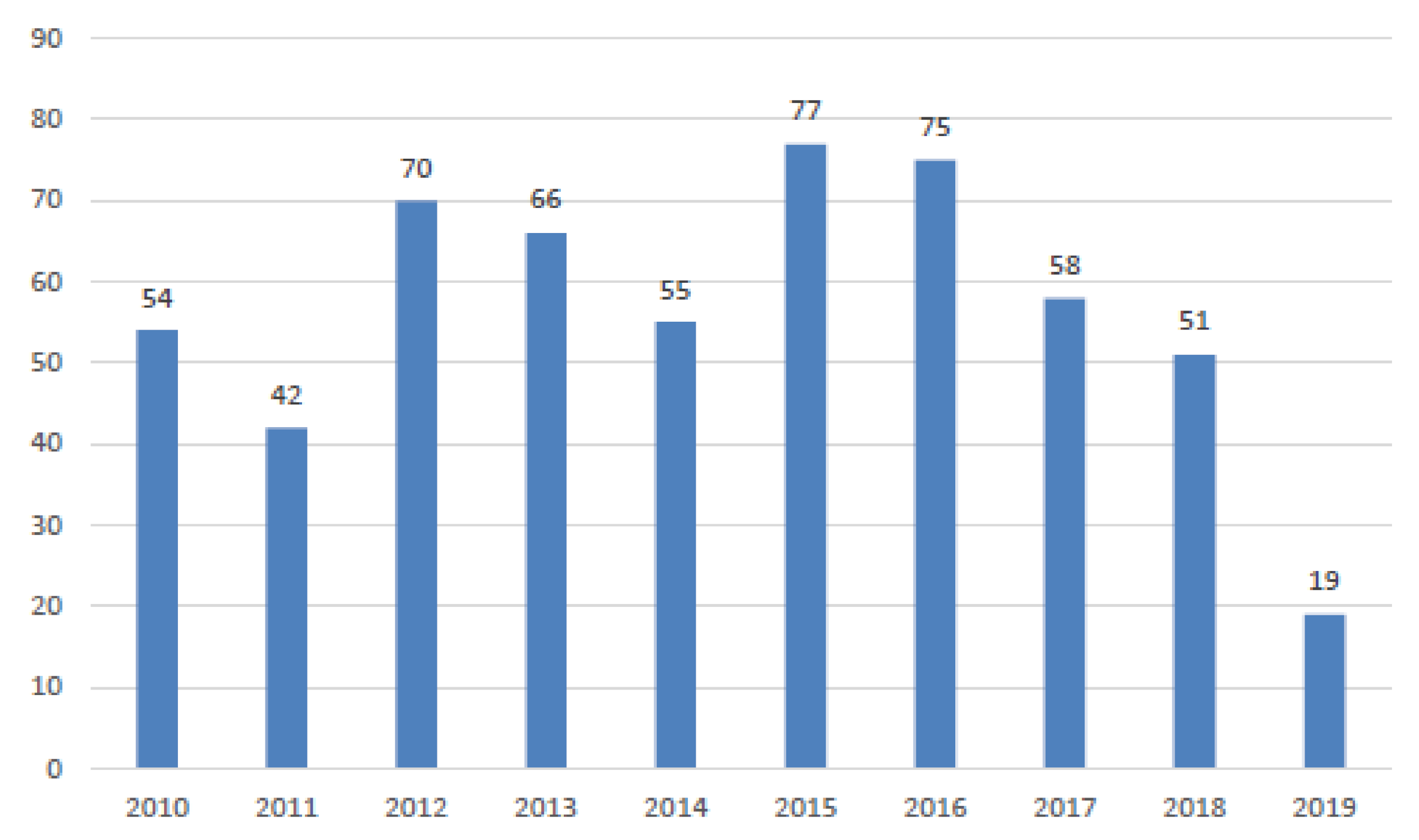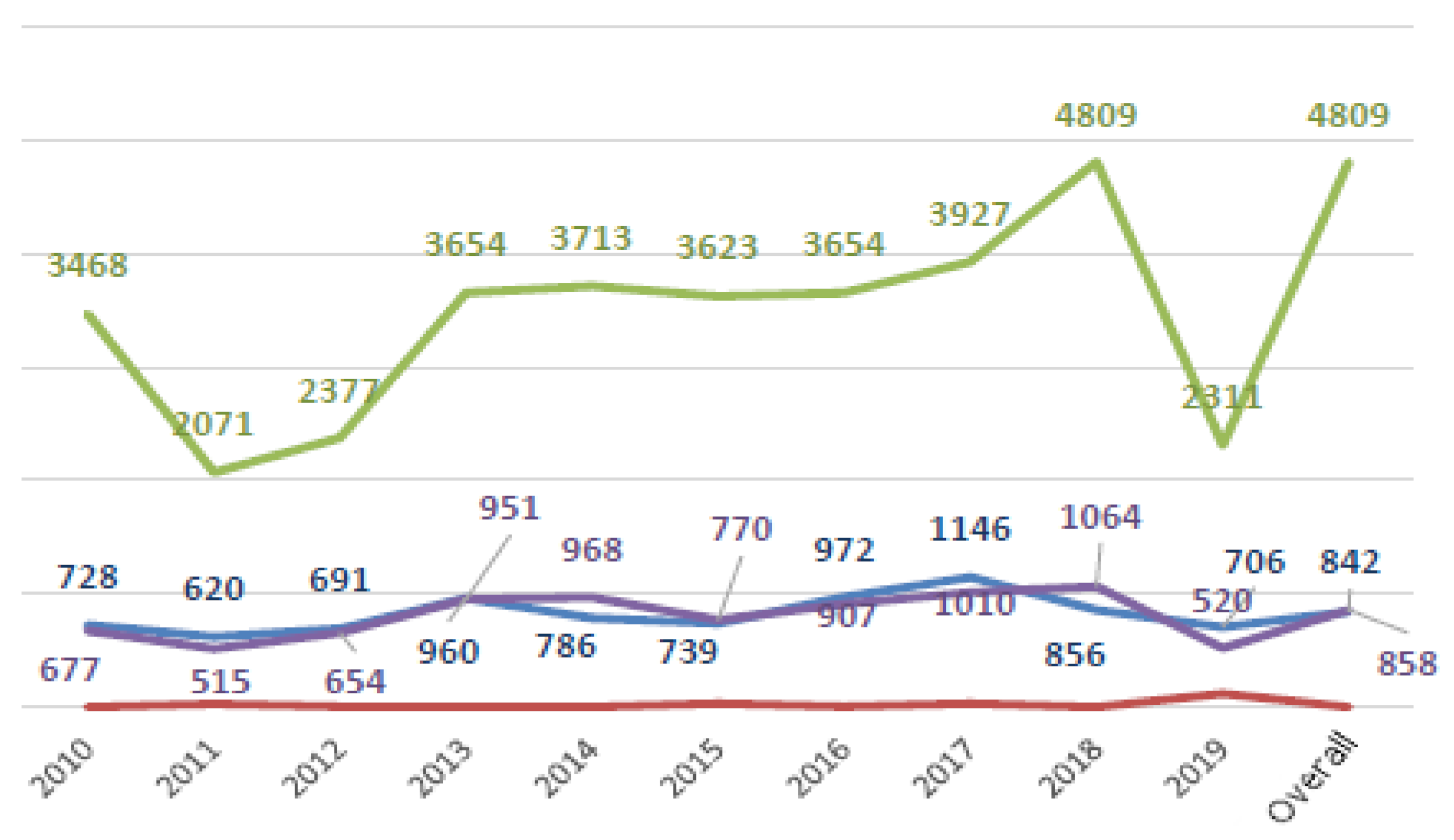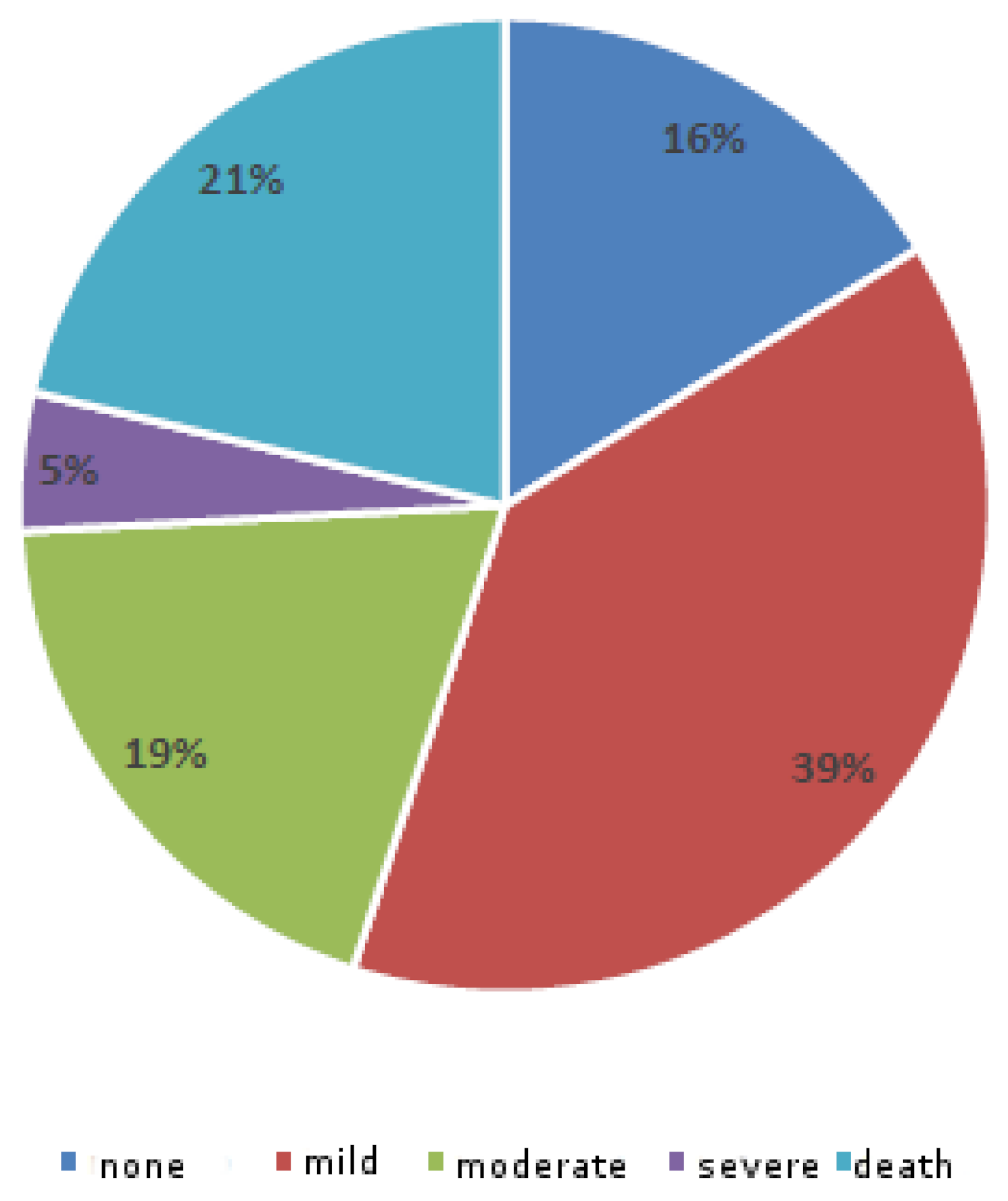Analysis of Inadequacies in Hospital Care through Medical Liability Litigation
Abstract
1. Introduction
2. Materials and Methods
3. Results
3.1. Epidemiological Data
3.2. Demographic Data and Units Involved
3.3. The Claims
4. Discussion
5. Conclusions
Author Contributions
Funding
Institutional Review Board Statement
Informed Consent Statement
Data Availability Statement
Conflicts of Interest
References
- Albolino, S.; Bellandi, T.; Cappelletti, S.; Di Paolo, M.; Fineschi, V.; Frati, P.; Offidani, C.; Tanzini, M.; Tartaglia, R.; Turillazzi, E. New Rules on Patient’s Safety and Professional Liability for the Italian Health Service. Curr. Pharm. Biotechnol. 2019, 20, 615–624. [Google Scholar] [CrossRef] [PubMed]
- Bellandi, T.; Tartaglia, R.; Sheikh, A.; Donaldson, L. Italy recognises patient safety as a fundamental right. BMJ 2017, 22, 2277. [Google Scholar] [CrossRef]
- The Joint Commission releases improving America’s hospitals: The Joint Commission’s annual report on quality and safety 2007. Jnt. Comm. Perspect. 2007, 27, 3.
- Hsieh, S.Y. The use of patient complaints to drive quality improvement: An exploratory study in Taiwan. Health Serv. Manag. Res. 2010, 23, 5–11. [Google Scholar] [CrossRef] [PubMed]
- Mello, M.M.; Studdert, D.M. Building a National Surveillance System for Malpractice Claims. Health Serv. Res. 2016, 51 (Suppl. 3), 2642–2648. [Google Scholar] [CrossRef]
- Greve, P.A., Jr. Anticipating and controlling rising malpractice insurance costs. Healthc. FinancManag. 2002, 56, 50–55. [Google Scholar]
- Riley-Smith, Q.T.; Heppinstall, A.; Foster, F. Is Covid-19 sowing the seeds for future litigation? Med. Leg. J. 2020, 88, 90–97. [Google Scholar] [CrossRef]
- Bilotta, C.; Zerbo, S.; Perrone, G.; Malta, G.; Argo, A. The medico-legal implications in medical malpractice claims during Covid-19 pandemic: Increase or trend reversal? Med. Leg. J. 2020, 88, 35–37. [Google Scholar] [CrossRef]
- Oliva, A.; Caputo, M.; Grassi, S.; Vetrugno, G.; Marazza, M.; Ponzanelli, G.; Cauda, R.; Scambia, G.; Forti, G.; Bellantone, R.; et al. Liability of Health Care Professionals and Institutions During COVID-19 Pandemic in Italy: Symposium Proceedings and Position Statement. J. Patient Saf. 2020, 16, e299–e302. [Google Scholar] [CrossRef]
- Pagano, A.M.; Maiese, A.; Izzo, C.; Maiese, A.; Ametrano, M.; De Matteis, A.; Attianese, M.R.; Busato, G.; Caruso, R.; Cestari, M.; et al. COVID-19 Risk Management and Screening in the Penitentiary Facilities of the Salerno Province in Southern Italy. Int. J. Environ. Res. Public Health 2020, 17, 8033. [Google Scholar] [CrossRef]
- Piccioni, A.; Cicchinelli, S.; Saviano, L.; Gilardi, E.; Zanza, C.; Brigida, M.; Tullo, G.; Volonnino, G.; Covino, M.; Franceschi, F.; et al. Risk management in first aid for acute drug intoxication. Int. J. Environ. Res. Public Health 2020, 17, 8021. [Google Scholar] [CrossRef]
- La Russa, R.; Fineschi, V.; Di Sanzo, M.; Gatto, V.; Santurro, A.; Martini, G.; Scopetti, M.; Frati, P. Personalized Medicine and Adverse Drug Reactions: The Experience of an Italian Teaching Hospital. Curr. Pharm. Biotechnol. 2017, 18, 274–281. [Google Scholar] [CrossRef]
- Ivers, N.; Jamtvedt, G.; Flottorp, S.; Young, J.M.; Odgaard-Jensen, J.; French, S.D.; O’Brien, M.A.; Johansen, M.; Grimshaw, J.; Oxman, A.D. Audit and feedback: Effects on professional practice and healthcare outcomes. Cochrane Database Syst. Rev. 2012, 6, CD000259. [Google Scholar] [CrossRef] [PubMed]
- Mirzoev, T.; Kane, S. Key strategies to improve systems for managing patient complaints within health facilities—What can we learn from the existing literature? Glob. Health Action 2018, 11, 1458938. [Google Scholar] [CrossRef]
- Jonsson, P.M.; òvretveit, J. Patient claims and complaints data for improving patient safety. Int. J. Health Care Qual. Assur. 2008, 21, 60–74. [Google Scholar] [CrossRef]
- Bishop, T.F.; Ryan, A.M.; Casalino, L.P. Paid malpractice claims for adverse events in inpatient and outpatient settings. JAMA 2011, 305, 2427–2431. [Google Scholar] [CrossRef]
- Javetz, R.; Stern, Z. Patients’ complaints as a management tool for continuous quality improvement. J. Manag. Med. 1996, 10, 39–48. [Google Scholar] [CrossRef]
- Bonetti, M.; Cirillo, P.; MusileTanzi, P.; Trinchero, E. An Analysis of the Number of Medical Malpractice Claims and Their Amounts. PLoS ONE 2016, 11, e0153362. [Google Scholar] [CrossRef]
- National Association of Insurance Companies (ANIA). Executive Summary 2015–2016. Available online: www.ania.it/InsuranceInsurance/2015–2016/ANIA-Italian-Insurance-2015-16.pdf (accessed on 2 January 2021).
- Marsh Risk Consulting. Report Medmal. In Annual Report About Medical Malpractice Trends in Private and Public Health Facilities in Italy, 9th ed.; Marsh Risk Consulting: Milan, Italy, 2018. [Google Scholar]
- Studdert, D.M.; Mello, M.M.; Gawande, A.A.; Gandhi, T.K.; Kachalia, A.; Yoon, C.; Puopolo, A.L.; Brennan, T.A. Claims, errors, and compensation payments in medical malpractice litigation. N. Engl. J. Med. 2006, 354, 2024–2033. [Google Scholar] [CrossRef]
- Adinma, J. Litigations and the Obstetrician in Clinical Practice. Ann. Med. Health Sci. Res. 2016, 6, 74–79. [Google Scholar] [CrossRef]
- Zerbo, S.; Malta, G.; Argo, A. Guidelines and Current Assessment of Health Care Responsibility in Italy. Risk Manag. Healthc. Policy 2020, 13, 183–189. [Google Scholar] [CrossRef] [PubMed]
- Levin, C.M.; Hopkins, J. Creating a Patient Complaint Capture and Resolution Process to Incorporate Best Practices for Patient-Centered Representation. Jnt. Comm. J. Qual. Patient Saf. 2014, 40, 484–492. [Google Scholar] [CrossRef]
- Leape, L.L. Error in medicine. JAMA 1994, 272, 1851–1857. [Google Scholar] [CrossRef] [PubMed]
- Giraldi, G.; Montesano, M.; Napoli, C.; Frati, P.; La Russa, R.; Santurro, A.; Scopetti, M.; Orsi, G.B. Healthcare-Associated Infections Due to Multidrug-Resistant Organisms: A Surveillance Study on Extra Hospital Stay and Direct Costs. Curr. Pharm. Biotechnol. 2019, 20, 643–652. [Google Scholar] [CrossRef]
- Siracusa, M.; Scuri, S.; Grappasonni, I.; Petrelli, F. Healthcare acquired infections: Malpractice and litigation issues. Ann. Ig. 2019, 31, 496–506. [Google Scholar]
- Albano, G.D.; Bertozzi, G.; Maglietta, F.; Montana, A.; Di Mizio, G.; Esposito, M.; Mazzeo, P.; D’Errico, S.; Salerno, M. Medical Records Quality as Prevention Tool for Healthcare-Associated Infections (HAIs) Related Litigation: A Case Series. Curr. Pharm. Biotechnol. 2019, 20, 653–657. [Google Scholar] [CrossRef]
- D’Errico, S.; Pennelli, S.; Colasurdo, A.P.; Frati, P.; Sicuro, L.; Fineschi, V. The right to be informed and fear of disclosure: Sustainability of a full error disclosure policy at an Italian cancer centre/clinic. BMC Health Serv. Res. 2015, 15, 130. [Google Scholar] [CrossRef]
- Cartocci, G.; Santurro, A.; La Russa, R.; Guglielmi, G.; Frati, P.; Fineschi, V. The choice of gadolinium-based contrast agents: A radiologist’s responsibility between pharmaceutical equivalence and bioethical issues. Symmetry 2017, 9, 287. [Google Scholar] [CrossRef]
- Bolcato, M.; Fassina, G.; Rodriguez, D.; Russo, M.; Aprile, A. The contribution of legal medicine in clinical risk management. BMC Health Serv. Res. 2019, 19, 85. [Google Scholar] [CrossRef]
- Yarmohammadian, M.H.; Abadi, T.N.; Tofighi, S.; Esfahani, S.S. Performance improvement through proactive risk assessment: Using failure modes and effects analysis. J. Educ. Health Promot. 2014, 3, 28. [Google Scholar] [PubMed]
- Gatto, V.; Scopetti, M.; La Russa, R.; Santurro, A.; Cipolloni, L.; Viola, R.V.; Di Sanzo, M.; Frati, P.; Fineschi, V. Advanced Loss Eventuality Assessment and Technical Estimates: An Integrated Approach for Management of Healthcare-Associated Infections. Curr. Pharm. Biotechnol. 2019, 20, 625–634. [Google Scholar] [CrossRef] [PubMed]




| Ranking | High-Incidence Departments | % Of Suitable Claims |
|---|---|---|
| 1 | Orthopedics and traumatology | 16.6 |
| 2 | Emergency department | 13.3 |
| 3 | General surgery | 11.4 |
| 4 | Neurosurgery | 7.7 |
| 5 | Radiology | 3.7 |
| Clinical Performance Sub-Category | Claims Numbers | Total Amounts (Euros) |
|---|---|---|
| Disapplication scientific evidences | 11 | 6,714,000 |
| Technical error | 65 | 5,614,000 |
| Missed or delayed diagnosis | 11 | 1,904,000 |
| Overall | 87 | 14,233,000 |
| Service Organization Inappropriateness | Claims Numbers | Total Amounts (Euros) |
|---|---|---|
| Specific procedure violation | 11 | 300,000 |
| Poor Health-care associated infection (HAI) prevention | 12 | 4,157,000 |
| Fall prevention violation | 4 | 43,000 |
| Suicide prevention violation | 1 | 370,000 |
| Overall | 28 | 4,871,000 |
| Operating Units | Claims Number (%) | Compensation Amount (%) |
|---|---|---|
| Orthopedics | 9 | 0 |
| Internal medicine | 8 | 5 |
| Urology | 17 | 9 |
| General surgery | 17 | 10 |
| Cardiac surgery | 8 | 10 |
| Neurosurgery | 17 | 15 |
| Cardiology | 8 | 16 |
| Vascular surgery | 8 | 17 |
| Neurology | 8 | 18 |
| Procedure | Claims Number | Ranking per Cumulative Amount |
|---|---|---|
| oro-tracheal intubation | 5 | 28th |
| lumbar spine surgery (elective) | 4 | 4th |
| radioulnar fracture treatment | 4 | 20th |
| unilateral kidney surgery | 3 | 6th |
| thyroidectomy (non-cancer) | 3 | 12th |
| thyroidectomy (oncological) | 3 | 14th |
| breast reconstruction | 2 | 13th |
| ovarian surgery | 2 | 18th |
| dental extraction | 2 | 41st |
| all the others | 1 | - |
| Procedure | Compensation Amount | Claims Number |
|---|---|---|
| tumor exeresis through craniotomy | 787,000 | 1 |
| aortic valve replacement | 600,000 | 1 |
| hemodialysis | 530,000 | 1 |
| lumbar spine surgery (elective) | 446,200 | 4 |
| trans-sphenoid tumor exeresis | 377,000 | 1 |
| unilateral kidney surgery | 362,900 | 3 |
| colorectal resection (elective) | 268,000 | 1 |
| shoulder arthroplasty | 265,300 | 1 |
| endovascular stenting | 228,200 | 1 |
| mandibular reconstruction | 182,000 | 1 |
Publisher’s Note: MDPI stays neutral with regard to jurisdictional claims in published maps and institutional affiliations. |
© 2021 by the authors. Licensee MDPI, Basel, Switzerland. This article is an open access article distributed under the terms and conditions of the Creative Commons Attribution (CC BY) license (http://creativecommons.org/licenses/by/4.0/).
Share and Cite
La Russa, R.; Viola, R.V.; D’Errico, S.; Aromatario, M.; Maiese, A.; Anibaldi, P.; Napoli, C.; Frati, P.; Fineschi, V. Analysis of Inadequacies in Hospital Care through Medical Liability Litigation. Int. J. Environ. Res. Public Health 2021, 18, 3425. https://doi.org/10.3390/ijerph18073425
La Russa R, Viola RV, D’Errico S, Aromatario M, Maiese A, Anibaldi P, Napoli C, Frati P, Fineschi V. Analysis of Inadequacies in Hospital Care through Medical Liability Litigation. International Journal of Environmental Research and Public Health. 2021; 18(7):3425. https://doi.org/10.3390/ijerph18073425
Chicago/Turabian StyleLa Russa, Raffaele, Rocco Valerio Viola, Stefano D’Errico, Mariarosaria Aromatario, Aniello Maiese, Paolo Anibaldi, Christian Napoli, Paola Frati, and Vittorio Fineschi. 2021. "Analysis of Inadequacies in Hospital Care through Medical Liability Litigation" International Journal of Environmental Research and Public Health 18, no. 7: 3425. https://doi.org/10.3390/ijerph18073425
APA StyleLa Russa, R., Viola, R. V., D’Errico, S., Aromatario, M., Maiese, A., Anibaldi, P., Napoli, C., Frati, P., & Fineschi, V. (2021). Analysis of Inadequacies in Hospital Care through Medical Liability Litigation. International Journal of Environmental Research and Public Health, 18(7), 3425. https://doi.org/10.3390/ijerph18073425








